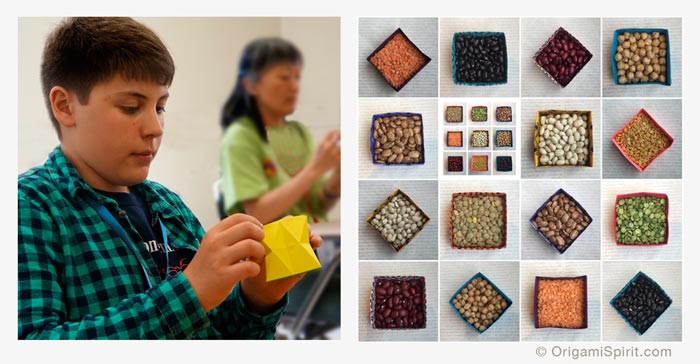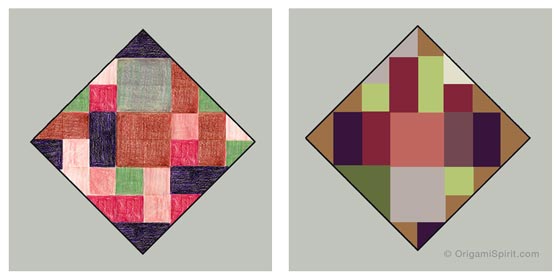Are you a teacher or a home-schooling parent? Did you know that origami can be used in the classroom as a teaching tool?
The art of paper folding is excellent to teach and improve math and vocabulary, and to introduce children to different cultures and to concepts of art, science and social studies. In addition, it can help develop motor skills, foster team work and encourage socialization.
Children love learning how to fold origami models and they are thrilled when learning different concepts through the use of origami!
As educators, we can teach children origami, but we can also use our creativity to choose different curriculum-related topics and teach them through origami.
Did you know, for example, that the United Nations declared 2016 as the International Year of Pulses?
A whole activity involving origami can be done with the students around the topic of pulses.
- Pulses are part of the legume family, but the term “pulse” refers only to the dried seed. Dried peas, edible beans, lentils and chickpeas are the most common varieties of pulses.
- The International Year of Pulses aims to heighten public awareness of the nutritional benefits of pulses as part of sustainable food production aimed towards food security and nutrition.
Sign up to receive a free teaching guide packed with ideas on using origami and different kinds of pulses (legume dried seeds) in the classroom to teach children concepts related to math, language, science, social studies and art.






Hello, I am from India & doing Origami since 1978. I love to teach origami to kids & anyone who wants to learn it. I am an Accountant by profession but a passionate Organist.
Whenever I teach ORIGAMI I also teach little Maths & other subjects I know.
I would like to use Origami more extensively in Education.
HAPPY FOLDING!!
Hi Govind,
Thank you for sharing about your passion and love for teaching this lovely art of paper folding.
Happy Folding!
Can we use origami to teach history ?
Sir please cite some examples ?
Hi Govind,
Thank you for your question. I share a couple of ideas here. You can have children learn historical events by having them fold items that can symbolize and illustrate a particular period.
Also, you can invite children to fold paper figures as part of learning the history of papermaking.
Leyla, Quiero darte un saludo especial, felicitarte porque tienes el don de enseñar.
Fui docente de arte, durante 18 años, en colegios de categoría en Colombia, Aunque mi trabajo actual tiene que ver con la fotografía y el diseño, continuo haciendo trabajo de adelantar niños con dificultades académicas, específicamente orientado a re-educar la parte psicomotora del individuo, utilizando el arte como herramienta pedagógica. Y ahí es donde entra el Origami o Papiroflexia. (Estoy escribiendo acerca del tema)
El arte de plegar me apasiona y admiro a sus creadores. Tus videos son espectaculares, cumple con uno de los objetivos del origami que es seguir instrucciones, además la producción visual es grandiosa.
Hola Javier,
Me alegra mucho que te sirva lo que encuentras en Origami Spirit, que ha sido una obra de amor a través de los años.
Muchas gracias por escribir y por tus cálidas palabras!
Una vez mas gracias Leyla por todo lo que comparte, Dios le bendiga esas esas manos!!!.
Me gustaria recibir la guia pedagogica.
Cordialmente,
Su seguidora, Ivonne
Con todo gusto Ivonne! Para recibir la guía puedes ir a la página correspondiente a esta, en español, Enlace https://www.origamispirit.com/es/2016/01/origami-en-el-aula/
Allí llenas el formulario que está en la parte inferior y sigues los pasos que se te indican.
Gracias por tu interés.
Leyla, is it possible to collect it when they come and collect the prints?? they should be coming next week sometime….I hope.
Kindest regards
Anna
Dear Anna,
In order to view the teaching guide, all you need to do is fill out the form appearing in this post. As soon as you do that, you’ll receive a link to the teaching guide.
By filling this form you will not receive any duplicate emails from us.
Let me know if this clarifies your question. Thank you for writing.
Leyla
I agree that origami that can be easily integrated into many different subject areas, and children as young as kindergarten love making very simple models, and “sneaking” in math language is very easy to do. Thank you Leyla for this great site!
Hi Alice,
Don’t we all like when we can entertain our students as we are teaching them valuable concepts? And a wonderful thing about origami is that it’s very adaptable to be used it in the classroom.
This is an excellent teaching technique. I worked with children with learning disabilities. I found that visual and hands on techniques worked very well. Every child can learn, it is finding the right approach. I loved the challenge.
Adapted Mind is a great site!
Thank you once again, Leyla!
Yes, Pat, we all learn in different ways. Origami is has a lot to offer to kinesthetic (tactile) and visual learners. The students carry out a physical activity. A perfect visual, tactile and hands-on technique!